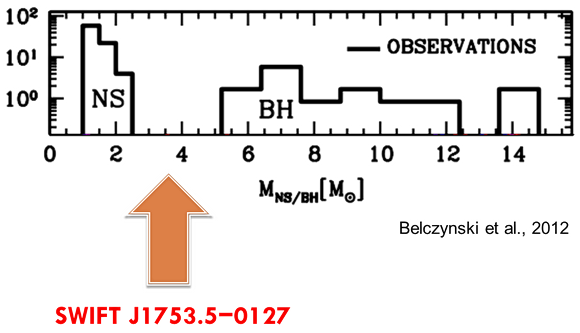Lightweight black hole challenges astronomers supernova explosion models.
Compact objects such as black holes and neutron stars are the end point of massive star evolution. Most of them are thought to have been formed in supernova explosions due to the collapse of the massive stellar core. It is to be expected that the masses of the resultant compact remnants correlate with the masses of their progenitor stars which have a smooth distribution in the range from the heaviest to the lightest stars. Surprisingly, the observed distribution of compact object masses seems to have a gap in the range between 2 to 5 solar masses. This gap, whose existence in the current sample of the mass measurements was fairly well established, has become a significant challenge to our understanding of compact object formation.
However, the existence of the gap has been brought into question. In our recent paper published in the Monthly Notices of the Royal Astronomical Society, we investigated X-ray transient system SWIFT J1753.5-0127 which exhibits X-ray properties typical for the black hole binary. For the first time, we performed the analysis of spectroscopic data to determine the system parameters and showed that it hosts one of the smallest stellar-mass black hole found to date, with the mass below 4 solar masses.

The presence or absence of the mass gap is a critical clue in understanding the formation of neutron stars and black holes and the engine behind supernova explosions. The result of the paper supports the possibility of existence of compact objects in the mass gap. This conclusion greatly limits the formation scenarios. For instance, in the rapid supernova explosion mechanisms, it is not possible to produce the compact objects with masses 3–5 solar masses, even accounting for the binary evolution effects. We suggest that the black hole in SWIFT J1753.5-0127 can either be produced in the delayed explosion or be the result of the accretion-induced collapse of a neutron star.
For more details see the article “Spectroscopic evidence for a low-mass black hole in SWIFT J1753.5-0127”, MNRAS, V.445, pp. 2424-2439 (2014) by V. Neustroev et al.
